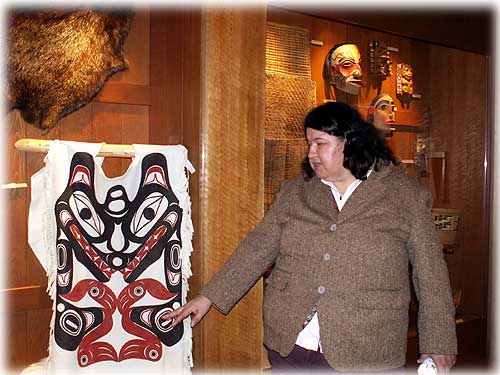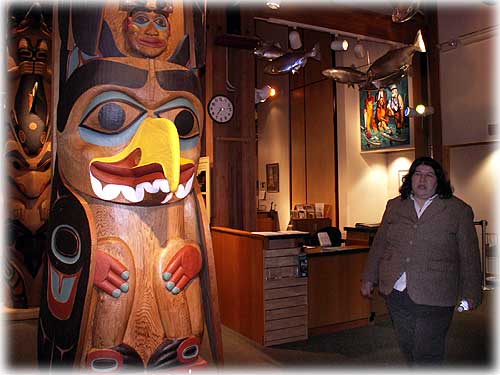 Discovering traditions and
customs
Discovering traditions and
customs
By Marie L. Monyak
March 13, 2006
Monday
Ketchikan, Alaska - The Friday Night Insight Program sponsored
by the Southeast Alaska Discovery Center offered a pleasant surprise
for those in attendance this past Friday. The scheduled presentation
had been cancelled and in its place was the opportunity to take
a guided tour of the Discovery Center instead.
Participants had the pleasure of being led through the Center's
Native Tradition Exhibit by Merle Nancy Hawkins, a direct descendant
of Haida Elder, Vesta Morrison Johnson and seasonal employee
of the Discovery Center.
 Haida Native, Discovery
Center tour guide and narrator, Merle Hawkins.
Haida Native, Discovery
Center tour guide and narrator, Merle Hawkins.
Hawkins is pointing out the display of items made from the spruce
tree bark or roots.
Photograph by Marie L. Monyak
Hawkins began her presentation by saying how much she enjoys
her position as a narrator/tour guide at the Discovery Center,
talking with the tourists every summer and educating them about
Native ways. "I've been here for nine seasons and I can't
believe that they pay me just to talk about my traditions and
customs," Hawkins exclaimed.
The group was led by Hawkins to the lobby of the Discovery Center
to view the three totem poles which provide a wonderful example
of the art style of the three Southeast Native Alaskan tribes;
Haida, Tlingit and Tsimshian.
Beginning with the Haida pole carved by James Hart of the Eagle
clan, Hawkins pointed out the carving of a Grizzly Bear, Killer
Whale and Eagle which represent the People of the Land, Sea and
Sky respectively. "Villages were situated with the ocean
in front, the forest behind them and the sky above to signify
all three people," Hawkins continued, "Also the sensory
organs, eye, nose and ears, are bold and prominent." The
totem pole was dedicated to the old Haida masters who developed
the art form to record history.
Next was the Tsimshian totem pole carved by David Boxley of the
Eagle clan that had the semblance of a Raven, Wolf, Killer Whale
and Eagle representing the four main clans of the coastal Tsimshian
people. The pole had been carved on site at the Discovery Center
several years back and was dedicated to all the Tsimshian people.
The last totem pole in the lobby was the Tlingit pole carved
by Israel Shotridge of the Tongass Tribe, Brown Bear clan. As
Hawkins explained, "The Raven and Eagle depicted are the
two main moieties of the Tlingit people, with the sub clans portrayed
by the Bear clan bentwood box at the bottom, the Frog above the
Raven and the Killer Whale in the middle just above the Tlingit
Chief."
Hawkins steered the group toward the wall where a framed button
robe, which she had crafted, was displayed. She explained, "The
design belongs to my clan and I had permission [to display it]
from my Clan Chief Richard Carl, who is now deceased." The
framed button robe wore the design of her clan; the Double Fin
Killer Whale. Since Hawkins moiety is Raven, the Killer Whale's
double fins were designed to appear in the likeness of a Raven's
head. The robe was signed by Hawkins with her Haida name Saand
Laany, which was given to her by her grandmother and means "Beautiful
Dawn."
Leaving the totem poles behind, the group proceeded to the Alaska
Rainforest display. Amazingly authentic, one felt the need to
reach out and touch a tree or plant to see if it was real but
of course they were not.
 Hawkins in the lobby
of the Discovery Center. The totem was carved by Israel Shotridge.
Hawkins in the lobby
of the Discovery Center. The totem was carved by Israel Shotridge.
Photograph by Marie L. Monyak
The trees displayed were Western Hemlock and as Hawkins stated,
"In the spring time, when the herring were spawning, Natives
would take branches from the young trees and put them in an inter-tidal
area and the herring schools would come in and spawn their white
eggs all over the branches. You take them home and cook them
in water and it's still a delicacy to this day."
Just beyond the trees was the muskeg area complete with devil's
club and skunk cabbage. To this day the thorny devil's club,
made into a tea, is used by Natives as a medicinal tonic
for various maladies.
Proceeding to the next exhibit, a re-creation of a Native fish
camp, Hawkins explained the methods that were used to catch salmon
and pointed out the tools in the display that were used to clean
the fish and prepare them for hanging from the drying racks before
being placed in the smokehouse.
The fish camp display included the many tools that were utilized
not only for cooking but for carving out canoes and the making
of bentwood boxes that were used in numerous ways for everything
from cooking to food storage.
The Natives were skilled craftsmen in that almost all tools,
utensils and weapons were made from some portion of the many
trees in the forest. The adz is a traditional chopping tool that
is used for carving totem poles, canoes, clan houses, and also
for cutting planks from fallen timbers to make the shingles for
the clan house roofs.
Hawkins pointed out a tree with a long, wide strip of bark hanging
from it and explained, "The Natives would strip bark from
live trees in the springtime when the sap is flowing. In this
way the tree would continue to live. I've seen culturally modified
trees in the forest that have had their bark harvested over a
hundred years ago and the tree is still healthy and alive.
Moving into the next room of the exhibit, now deceased Tlingit
Elder Esther Shea can be heard on a recording, explaining the
Native way of life and how nature provided everything that was
needed.
There were glassed exhibits that encased items which were made
from the Spruce tree roots and bark such as baskets, hats and
clothing. Another displayed clothing and regalia made from the
skin, fur and hides of many animals.
Hawkins drew the group's attention to a beautiful Chilcat tunic,
"This is made out of mountain goat fur and red cedar bark.
The materials were gathered by the women and spun on their thighs.
It would take up to a year to weave one but once material was
introduced they began making the button robes."
Examples of the foods that were provided by nature were displayed
in yet another exhibit. Seaweed, dried hooligan, herring eggs,
salmon and berries, all the bounty from both land and sea were
shown alongside traditional hand carved bowls, bentwood boxes
and utensils used in the preparation, consumption and storage
of the food gathered by the village.
The last display that Hawkins would direct everyone's attention
to was a wall with ten framed oil painting of the Elders, some
living and some deceased. Hawkins pointed out the portrait of
Esther Shea (deceased) whom she said, "taught me a lot at
the University and other classes."
Hawkins continued, "The portrait on the end is Ernie Smeltzer
and you can see the colors of his Chilcat tunic." Pointing
out several more paintings of Elders, Hawkins said, "This
is Erma Lawrence, she's 93 years old and she has wonderful stories
to tell and she's working every day on the preservation of the
Haida language. This one is Phyllis Almquist, she's been my neighbor
for 50 years and she's a treasure. I'm very fortunate to have
known all these people.
Hawkins concluded the tour and thanked everyone for attending
but remained behind to speak with the group and answer questions
from those thirsty for even more Native history.
The next Friday Night Insight Program at the Southeast Alaska
Discovery Center will be held on March 17th at 7:00 P.M. Local
mom and visionary, Dawn Rauwolf will be discussing the exciting
idea of an educational museum designed specifically for children
in her presentation, "A Children's Museum in Ketchikan?"
On the Web:
Southeast Alaska Discovery
Center's Native arts and exhibits
http://www.fs.fed.us/r10/tongass/districts/discoverycenter/virtour.html
Three totem pole artists mentioned
in the article.
David Boxley
http://www.davidboxley.com/bio.asp
Israel Shotridge
http://www.shotridgestudios.com/culture.html
James Hart
http://www.civilization.ca/aborig/haida/haaat07e.html
Marie L. Monyak is
a freelance writer living in Ketchikan, Alaska.
A freelance writer is an uncommitted independent writer
who produces and sells articles to a publisher such as SitNews.
Contact Marie at mlmx1[at]hotmail.com
Send your story ideas
to editor@sitnews us
Publish A Letter on SitNews Read Letters/Opinions
Contact the Editor
SitNews
Stories In The News
Ketchikan, Alaska
|


